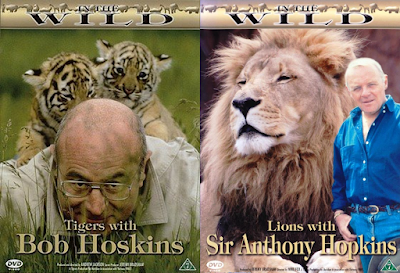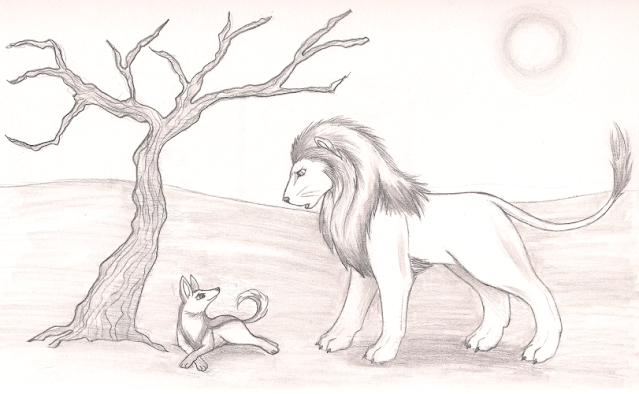In the Wild (Similarities and Differences)
Important plot points may be given away
'In the Wild' was a television series that explored the favourite animal of a particular Hollywood star. Two of the best known Episodes are Tigers with Bob Hoskins and Lions with Anthony Hopkins where Hoskins and Hopkins went into the wild to see their favourite animals, the tiger and the lion respectively. While each episode was different in the animal that was being followed, there are also a few similarities (May contain spoilers)
- Both Anthony Hopkins and Bob Hoskins are veteran actors and both have similar sounding surnames. Their favourite big cats are also popular. However unlike Hoskins, Hopkins has a cat
- The start of each Episode reveals how a big cat has come to be the favourite of the actor and when they first saw their favourite animal in captivity. Anthony Hopkins first saw a lion at the zoo and Bob Hoskins first saw a tiger at the circus and both of them were children at the time. However, Hoskins actually served in the circus for a while. Both actors also talk about how popular their favourite animal has come to be even though unlike the lion which has made a name for himself all over the world, the tiger despite being equally popular has not made the same mark for himself and seems to be popular only in the circus
- Hoskins and Hopkins join veterinary people to dart their favourite big cat and take body samples from the animals. The big cats that are darted are also female. However Hoskins helps to dart a captive tigress born in the wild in a tiger park in Sumatra with renowned Tiger expert Ron Tilson while Hopkins helps to dart a lioness in the wilds of the Serengeti in Tanzania with the Serengeti Lion Project and its noted members Pamela Bell, Sarah Legge, Dr Melody Roelke-Parker and Dr Sarah Durrant of the University of Minnesota. Also while the cats are being darted, they remove the dart from their body while its medicine takes effect on them but the lioness growls while taking out the dart while the tigress makes no sound. Both cats are also partly awake but unable to do anything while being examined because of the effect of the dart’s medicine. The veterinary people also examinine the big cats to make sure that they are in good health though while the people darting the lioness are doing so to radio-collar her and make sure she is in good health, the people darting the tigress are doing to in order to make sure she is receptive enough to cross-breed with a male tiger from a zoo
- Hopkins and Hoskins talk about how their favourite big cat sometimes attack people, yet Hopkins talks about man-eating Lions from a 1900s point of view, relating to two famous lions who halted construction of the Kenya-Uganda Railway in Tsavo, Kenya (Neighbouring Tanzania where Hopkins goes to see lions) by killing between 28 and 35 people as well as a hunter whom they pulled from a carriage. Hoskins talks about man-eating tigers from a modern point of view, going as far as to cover why Tigers become man-eaters, people who have suffered from tiger attack and what happens to man-eating tigers. Hopkins and Hoskins also meet people in villages who bear scars both emotional and physical from attack by the actors’ favourite big cats however Hoskins meets the family of a woman killed by a tiger that was later caught and sent to Kathmandu zoo while Hopkins meets a Masai who fought a lion that was trying to attack his cattle and bore scars on his face and body even though he managed to kill the lion with a sword
- Hopkins and Hoskins go to visit people who have a seeming connection with their favourite big cat as well as the experiences that these people have gained from the Animal. Hopkins visits the Masai who both revere and hunt the lion, especially if he kills their cattle and Hoskins visits people in Central Sumatra who identify themselves with the spirit of the tiger and who worship him as a God much like Egyptians worship the lion as a God as Hopkins mentions before going to Tanzania
- The favourite big bats of Hopkins and Hoskins are shown hunting mostly their favourite prey species, the lion hunting zebra and the tiger hunting deer. However while Hopkins views a pride of lions hunting zebras, Hoskins misses a tiger hunting deer only coming across the body of a deer killed by the tiger
- The national parks that Hopkins and Hoskins visit are known for rhinos; Tanzania's Ngorongoro Crater (responsible for the creation of the Serengeti) and Nepal's Bardia national park are known for the black rhinoceros and Indian rhinoceros respectively. Both species of rhinoceros are endangered. While Hopkins and Hoskins see a rhinoceros during their safari, they are more interested in seeing their favourite big cat, the lion and the tiger respectively
- Both Hopkins and Hoskins accompany their wildlife cameraman Hugh Maynard to film their favourite big cat, yet Hopkins accompanies Maynard for most of his stay in the Ngorongoro crater when watching Lions while Hoskins accompanies Maynard into a shed built near a tiger kill in hopes of seeing the big cat back at the kill again yet no tiger is spotted even though both Hoskins and Maynard stay there for hours into the night and Hoskins leaves after some time
- Hopkins and Hoskins both see cubs of their favourite big cats though while Hopkins manages to see newborn lion cubs, Hoskins only sees teenage tiger cubs interact with their father while their mother is away hunting. While both actors manage to see savage interaction between the cubs and their parents, in the case of the Lion it is more graphic and savage than the Tiger
- The favourite big cats of Hopkins and Hoskins are seen practicing stalking birds as a lesson for hunting. Young Lions are seen practicing on guineafowl and young tigers are seen practicing on peacocks
- Both Hopkins and Hoskins see their favourite big cat hunting a member of the cattle family though Hopkins sees a pride of lions chase a herd of buffalo, pulling down one member of the herd while Hoskins sees a tiger chasing a herd of gaur (Indian bison) with no success
- At the end, both Anthony Hopkins and Bob Hoskins talk about the importance of each of their favourite big cats and how it is necessary to conserve them though Hoskins throws emphasis on the tiger’s survival while Hopkins talks about ways in which the Lion is conserved. This is probably because unlike the tiger, the lion is not an endangered species




Comments
Post a Comment